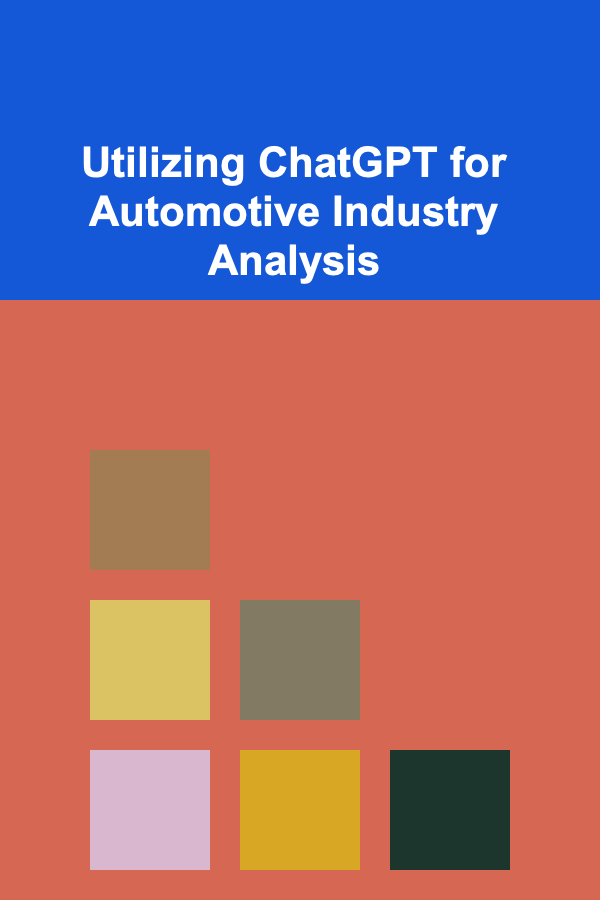
Utilizing ChatGPT for Automotive Industry Analysis
ebook include PDF & Audio bundle (Micro Guide)
$12.99$8.99
Limited Time Offer! Order within the next:

The automotive industry is undergoing a period of unprecedented transformation. Driven by technological advancements, shifting consumer preferences, and increasing environmental concerns, the landscape is becoming increasingly complex and dynamic. Traditional business models are being challenged, new players are entering the market, and the pace of innovation is accelerating. In this environment, robust and timely industry analysis is more crucial than ever for automotive manufacturers, suppliers, investors, and policymakers. ChatGPT, a powerful large language model (LLM) developed by OpenAI, offers a unique and versatile tool for navigating this complexity and extracting valuable insights from the vast amount of data available.
Understanding the Automotive Industry Landscape
Before delving into specific use cases, it's important to understand the key trends shaping the automotive industry today. These include:
- Electrification: The shift towards electric vehicles (EVs) is arguably the most significant trend. Government regulations, falling battery prices, and increasing consumer demand are driving the adoption of EVs across all vehicle segments. This trend requires understanding battery technology, charging infrastructure, supply chain dynamics, and the impact on traditional internal combustion engine (ICE) vehicle manufacturers.
- Autonomous Driving: The development of self-driving vehicles promises to revolutionize transportation. Companies are investing heavily in autonomous driving technologies, including sensors, software, and AI algorithms. Understanding the regulatory landscape, technological challenges, and ethical considerations surrounding autonomous driving is crucial.
- Connectivity: Connected car technologies are transforming the driving experience and enabling new business models. Vehicles are becoming increasingly connected to the internet, allowing for over-the-air software updates, remote diagnostics, and personalized services. Understanding cybersecurity risks, data privacy concerns, and the potential for new revenue streams through connected services is paramount.
- Shared Mobility: Ride-hailing services, carsharing programs, and micro-mobility solutions are changing how people access transportation. These trends are impacting vehicle ownership patterns and creating new opportunities for automotive manufacturers to offer mobility-as-a-service (MaaS) solutions. Understanding the impact on urban planning, traffic congestion, and the demand for different types of vehicles is essential.
- Digitalization: Digital technologies are transforming every aspect of the automotive industry, from design and manufacturing to sales and marketing. Companies are leveraging data analytics, artificial intelligence, and cloud computing to improve efficiency, personalize customer experiences, and develop new products and services. Understanding the skills gap, the need for digital transformation strategies, and the potential for disruption from tech companies is vital.
- Supply Chain Disruptions: The automotive industry has faced significant supply chain challenges in recent years, including semiconductor shortages, raw material price volatility, and geopolitical uncertainties. Understanding supply chain vulnerabilities, building resilience, and diversifying sourcing strategies are critical for mitigating risks.
- Sustainability and ESG: Environmental, Social, and Governance (ESG) factors are increasingly important to investors, consumers, and employees. Automotive companies are under pressure to reduce their carbon footprint, improve labor practices, and promote diversity and inclusion. Understanding ESG reporting requirements, developing sustainable manufacturing processes, and investing in renewable energy are becoming essential for long-term success.
These trends are interconnected and create a complex and rapidly evolving environment. ChatGPT can be a powerful tool for navigating this complexity and gaining a deeper understanding of the key drivers of change.
Specific Applications of ChatGPT in Automotive Industry Analysis
ChatGPT can be leveraged for a wide range of applications in automotive industry analysis. Here are some key areas:
1. Market Research and Competitive Intelligence
ChatGPT can significantly accelerate and enhance market research efforts by:
- Analyzing Market Trends: By providing ChatGPT with prompts such as "What are the key trends in the electric vehicle market in Europe?", you can quickly gather insights from a wide range of sources, including news articles, industry reports, and social media data. ChatGPT can synthesize this information and provide a concise summary of the key trends.
- Profiling Competitors: ChatGPT can be used to gather information about competitors' strategies, products, and financial performance. For example, you can ask ChatGPT to "Summarize Tesla's strategy for entering the Indian market" or "Analyze the strengths and weaknesses of Volkswagen's electric vehicle lineup."
- Identifying Emerging Technologies: By providing ChatGPT with prompts related to specific technologies, such as "What are the latest advancements in solid-state battery technology?", you can stay informed about the latest innovations and their potential impact on the automotive industry.
- Understanding Consumer Preferences: ChatGPT can analyze social media conversations, online reviews, and customer surveys to identify consumer preferences and emerging needs. For example, you can ask ChatGPT to "Analyze customer reviews of the Ford F-150 Lightning to identify common complaints and areas for improvement."
- Generating Market Reports: While ChatGPT cannot directly replace professional market research reports, it can be used to generate preliminary drafts or summaries of key findings, saving analysts significant time and effort. You can provide ChatGPT with specific data points and ask it to create a report outlining the key market trends and competitive landscape.
Example Prompt: "Analyze the impact of the Inflation Reduction Act on the electric vehicle market in the United States."
Expected Output: ChatGPT would analyze the provisions of the Inflation Reduction Act related to electric vehicles and provide insights into how the act is expected to impact EV sales, manufacturing, and the overall competitive landscape. It would likely discuss the impact of tax credits, domestic sourcing requirements, and the incentives for battery manufacturing in the US.
2. Financial Analysis and Investment Research
ChatGPT can assist with financial analysis and investment research by:
- Analyzing Financial Statements: ChatGPT can be used to quickly extract key financial data from company reports and analyze financial ratios. For example, you can ask ChatGPT to "Calculate the debt-to-equity ratio for General Motors and compare it to the industry average."
- Forecasting Financial Performance: By providing ChatGPT with historical financial data and industry forecasts, you can generate preliminary financial forecasts for automotive companies. While these forecasts should not be relied upon without further analysis, they can provide a starting point for more detailed modeling.
- Assessing Investment Risks: ChatGPT can be used to identify potential investment risks associated with specific automotive companies or technologies. For example, you can ask ChatGPT to "Identify the key risks associated with investing in autonomous driving technology."
- Evaluating Mergers and Acquisitions: ChatGPT can analyze the potential synergies and risks associated with mergers and acquisitions in the automotive industry. You can provide ChatGPT with information about the companies involved and ask it to assess the potential impact on market share, profitability, and innovation.
- Analyzing Macroeconomic Factors: ChatGPT can assess the impact of macroeconomic factors, such as interest rates, inflation, and economic growth, on the automotive industry. You can ask ChatGPT to "Analyze the impact of rising interest rates on auto loan demand."
Example Prompt: "Analyze the financial performance of Tesla over the past five years and identify the key drivers of its growth."
Expected Output: ChatGPT would analyze Tesla's revenue, profitability, cash flow, and other key financial metrics over the past five years. It would likely identify factors such as increasing vehicle sales, battery technology advancements, and government subsidies as key drivers of its growth. It might also point out areas of concern such as high debt levels or dependence on regulatory credits.
3. Technology and Innovation Assessment
ChatGPT is particularly valuable for understanding the rapidly evolving technology landscape by:
- Evaluating Emerging Technologies: ChatGPT can be used to gather information about emerging technologies such as solid-state batteries, advanced driver-assistance systems (ADAS), and over-the-air (OTA) software updates. You can ask ChatGPT to "Compare the advantages and disadvantages of solid-state batteries compared to lithium-ion batteries" or "Explain the functionality of Level 3 autonomous driving systems."
- Identifying Technological Disruptions: ChatGPT can help identify potential technological disruptions that could reshape the automotive industry. For example, you can ask ChatGPT to "Assess the potential impact of quantum computing on the automotive industry."
- Analyzing Patent Data: ChatGPT can analyze patent data to identify trends in technological innovation and identify key players in specific technology areas. You can provide ChatGPT with patent numbers or keywords and ask it to summarize the key inventions and their potential applications.
- Benchmarking Technological Capabilities: ChatGPT can be used to benchmark the technological capabilities of different automotive companies. For example, you can ask ChatGPT to "Compare the ADAS capabilities of Tesla, Waymo, and Mobileye."
- Generating Technical Documentation: ChatGPT can assist in generating technical documentation for new technologies, helping engineers and researchers communicate their findings more effectively.
Example Prompt: "Compare the lidar technology used by Velodyne and Luminar in terms of range, resolution, and cost."
Expected Output: ChatGPT would provide a comparative analysis of Velodyne and Luminar's lidar technology, highlighting the differences in their key specifications (range, resolution), and providing a qualitative assessment of their relative cost. This information can be valuable for understanding the trade-offs between different lidar technologies and their suitability for different autonomous driving applications.
4. Regulatory and Policy Analysis
The automotive industry is heavily regulated, and ChatGPT can help navigate the complex regulatory landscape by:
- Summarizing Regulations: ChatGPT can be used to summarize key regulations related to the automotive industry, such as emissions standards, safety regulations, and data privacy laws. You can ask ChatGPT to "Summarize the European Union's emissions standards for passenger vehicles" or "Explain the California Consumer Privacy Act (CCPA) and its implications for connected car data."
- Analyzing Policy Impacts: ChatGPT can assess the potential impact of government policies on the automotive industry. For example, you can ask ChatGPT to "Analyze the impact of government subsidies for electric vehicles on the adoption rate of EVs."
- Monitoring Regulatory Changes: ChatGPT can be used to monitor regulatory changes and identify potential compliance challenges. You can set up alerts to notify you when new regulations are issued or existing regulations are amended.
- Understanding International Trade Agreements: ChatGPT can analyze the impact of international trade agreements on the automotive industry. You can ask ChatGPT to "Analyze the impact of the USMCA trade agreement on automotive manufacturing in North America."
- Predicting Regulatory Trends: While not foolproof, by analyzing past regulatory decisions and current policy debates, ChatGPT can offer insights into potential future regulatory trends.
Example Prompt: "Summarize the key provisions of the Corporate Sustainability Reporting Directive (CSRD) and its implications for automotive companies operating in Europe."
Expected Output: ChatGPT would provide a summary of the CSRD, outlining its key reporting requirements related to environmental, social, and governance (ESG) factors. It would explain how the directive will impact automotive companies operating in Europe, including the increased transparency requirements and the need to integrate sustainability considerations into their business strategies.
5. Supply Chain Analysis and Risk Management
ChatGPT can be a valuable tool for analyzing supply chain vulnerabilities and mitigating risks by:
- Identifying Supply Chain Risks: ChatGPT can identify potential supply chain risks, such as geopolitical instability, natural disasters, and supplier bankruptcies. You can ask ChatGPT to "Identify the potential risks to the supply of semiconductors for the automotive industry" or "Analyze the impact of the war in Ukraine on the automotive supply chain."
- Mapping Supply Chains: ChatGPT can assist in mapping the supply chains for key automotive components and materials. You can provide ChatGPT with information about the suppliers and their locations and ask it to create a visual representation of the supply chain.
- Assessing Supplier Performance: ChatGPT can analyze data on supplier performance, such as on-time delivery rates, quality control metrics, and financial stability, to identify potential vulnerabilities.
- Developing Contingency Plans: ChatGPT can help develop contingency plans for mitigating supply chain disruptions. You can ask ChatGPT to "Suggest alternative sourcing options for key automotive components in the event of a disruption to the primary supply chain."
- Optimizing Inventory Management: ChatGPT can analyze demand patterns and lead times to optimize inventory management and reduce the risk of stockouts.
Example Prompt: "Analyze the potential impact of a rare earth element shortage on the production of electric vehicle batteries."
Expected Output: ChatGPT would analyze the dependence of EV batteries on rare earth elements, identify the major sources of these elements, and assess the potential consequences of a shortage. This would include potential price increases, production delays, and the need for alternative battery chemistries that rely on less scarce materials. It would also highlight the geopolitical implications related to rare earth element supply chains.
6. Sales and Marketing Strategy
ChatGPT can be used to enhance sales and marketing efforts by:
- Generating Marketing Content: ChatGPT can be used to generate marketing content such as blog posts, social media updates, and email newsletters. You can provide ChatGPT with a brief description of the target audience and the key message you want to convey.
- Personalizing Customer Interactions: ChatGPT can be used to personalize customer interactions by analyzing customer data and tailoring messages to their individual needs and preferences. This is especially useful in chatbots implemented on automotive company websites.
- Analyzing Customer Feedback: ChatGPT can analyze customer feedback from surveys, reviews, and social media to identify areas for improvement in products and services.
- Identifying New Market Segments: ChatGPT can analyze demographic data and consumer trends to identify new market segments that are likely to be interested in specific automotive products or services.
- Developing Sales Scripts: ChatGPT can generate sales scripts for dealerships and online sales channels, ensuring consistent messaging and maximizing conversion rates.
Example Prompt: "Write a social media post promoting a new electric SUV, highlighting its range, safety features, and environmental benefits."
Expected Output: ChatGPT would generate a social media post tailored for platforms like Twitter, Facebook, or Instagram. The post would likely be concise, engaging, and focus on the key selling points of the electric SUV, emphasizing its long range, advanced safety technologies, and its contribution to a more sustainable future. It might include relevant hashtags to increase visibility.
Best Practices for Using ChatGPT Effectively
While ChatGPT is a powerful tool, it's important to use it effectively to get the best results. Here are some best practices:
- Provide Clear and Specific Prompts: The more specific and detailed your prompts, the better the results you will get. Avoid vague or ambiguous language. Instead of asking "What's happening in the automotive industry?", ask "What are the key trends in the electric vehicle market in Europe in 2024?"
- Iterate and Refine Your Prompts: Don't be afraid to experiment with different prompts and refine them based on the results you get. It often takes several iterations to get the desired output.
- Verify the Accuracy of the Information: ChatGPT is a language model, not a fact-checker. Always verify the accuracy of the information it provides by cross-referencing it with reliable sources.
- Be Aware of Biases: ChatGPT is trained on a massive dataset of text and code, which may contain biases. Be aware of these biases and critically evaluate the information it provides.
- Use ChatGPT as a Starting Point, Not an End Point: ChatGPT should be used as a tool to augment your own analysis, not to replace it. Use the information it provides as a starting point for further research and analysis.
- Protect Sensitive Information: Do not share sensitive or confidential information with ChatGPT, as it may be stored and used to train the model.
- Understand the Limitations: ChatGPT is not a substitute for human expertise. It is a tool that can help you gather information and generate insights, but it cannot replace the judgment and experience of a skilled analyst.
- Leverage Chain-of-Thought Prompting: For more complex analyses, use chain-of-thought prompting. This involves guiding ChatGPT step-by-step through the reasoning process, rather than simply asking for the final answer. For example, instead of asking "What is the impact of battery prices on EV adoption?", ask "First, what are the factors affecting battery prices? Second, how do lower battery prices affect the upfront cost of EVs? Third, how does the upfront cost of EVs affect consumer demand?".
- Experiment with Different Models and Parameters: OpenAI offers different versions of ChatGPT with varying capabilities. Experiment with different models to see which one works best for your specific needs. You can also adjust parameters such as temperature and top_p to control the creativity and randomness of the output.
Challenges and Limitations
Despite its potential, using ChatGPT for automotive industry analysis also presents challenges and limitations:
- Accuracy and Reliability: As mentioned earlier, ChatGPT is not a fact-checker and can sometimes generate inaccurate or misleading information. This is particularly true when dealing with complex or nuanced topics.
- Bias: The training data used to develop ChatGPT may contain biases that can influence its output. This can lead to skewed or unfair results.
- Hallucinations: ChatGPT can sometimes "hallucinate" information, meaning it makes up facts or claims that are not based on reality.
- Lack of Real-World Experience: ChatGPT does not have real-world experience in the automotive industry. It relies solely on the information it has been trained on, which may not always be up-to-date or accurate.
- Data Privacy and Security: Sharing sensitive information with ChatGPT can pose data privacy and security risks. It's crucial to avoid providing any confidential or proprietary information.
- Over-Reliance: Over-reliance on ChatGPT can stifle critical thinking and independent analysis. It's important to use it as a tool to augment your own expertise, not to replace it.
- Cost: Using ChatGPT can be expensive, especially for large-scale projects. It's important to consider the cost-benefit ratio before investing in this technology.
The Future of Automotive Industry Analysis with AI
The integration of AI, including large language models like ChatGPT, into automotive industry analysis is only just beginning. As AI technology continues to evolve, we can expect to see even more sophisticated applications emerge. These may include:
- Predictive Analytics: AI can be used to develop predictive models that forecast future trends in the automotive industry, such as sales, market share, and technology adoption rates.
- Real-Time Monitoring: AI can be used to monitor real-time data from various sources, such as social media, news feeds, and sensor data, to identify emerging trends and potential disruptions.
- Automated Reporting: AI can automate the process of generating reports and presentations, freeing up analysts to focus on more strategic tasks.
- Personalized Insights: AI can personalize insights based on individual user needs and preferences, providing tailored information to different stakeholders.
- AI-Powered Design and Engineering: AI can be used to optimize vehicle design, improve manufacturing processes, and develop new materials.
The key to unlocking the full potential of AI in automotive industry analysis lies in combining AI technology with human expertise. By leveraging the strengths of both AI and human analysts, we can gain a deeper understanding of the complex dynamics shaping the automotive industry and make more informed decisions.
Conclusion
ChatGPT offers a powerful and versatile tool for automotive industry analysis, enabling users to quickly gather information, analyze trends, and generate insights. By understanding the key trends shaping the industry and following best practices for using ChatGPT effectively, automotive professionals can leverage this technology to gain a competitive edge. However, it's crucial to be aware of the limitations of ChatGPT and to always verify the accuracy of the information it provides. As AI technology continues to evolve, we can expect to see even more sophisticated applications emerge, transforming the way we analyze and understand the automotive industry. By embracing AI while maintaining a critical and informed approach, automotive professionals can navigate the complexities of this rapidly changing landscape and drive innovation and growth.

How to Decorate Your Living Room on a Tight Budget
Read More
How to Photograph Your Jewelry Collection for Insurance Purposes
Read More
How to Provide Excellent Customer Service to Your Tenants
Read More
How to Soundproof a Door to Block Outside Noise
Read More
How to Train Your Family on Home Security and Safety Procedures
Read More
How to Use Paint to Refresh Your Home Decor Without Breaking the Bank
Read MoreOther Products

How to Decorate Your Living Room on a Tight Budget
Read More
How to Photograph Your Jewelry Collection for Insurance Purposes
Read More
How to Provide Excellent Customer Service to Your Tenants
Read More
How to Soundproof a Door to Block Outside Noise
Read More
How to Train Your Family on Home Security and Safety Procedures
Read More